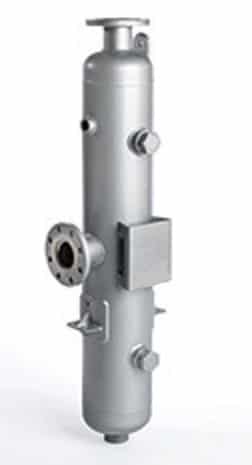Flash Vessel
When steam at a higher pressure is used in a process or heat exchanger, the resulting condensate can still be at a very high temperature in its’ liquid phase. As it passes through a steam trap and vents to an atmospheric tank, such as a boiler feedwater tank or condensate recovery unit; that energy can be lost as either flash vented steam or in cooling down in the return pipework.
Flash vessels provide a simple and effective way of capturing some of that energy that would otherwise be lost.



Speak with our valve experts
Fill out our quick and easy contact form with your enquiry and we'll get back to you.
What is Flash Steam?
Saturated steam when condensed at 4 bar g pressure for example, has a temperature of 1510C and in the liquid phase has around 640 kJ/ kg of energy. When flashed to atmospheric pressure, the water boils at around 1000C and has around 419 kJ/kg of energy. The now excess temperature between 1510C and 1000C and the resulting, now excess energy of (640-419) 221 kJ/kg, boils some of the water off as flash steam.
If this is captured and used at 1 barg pressure at 1200 C and with 505 kJ/kg of energy the amount of excess energy available as flash steam is now reduced to (640-505) 135 kJ/kg.
The pressure at which the flash steam is to be used must be considered carefully. The flow of flash may vary particularly if the hot condensate supply is from temperature-controlled plant. The type of steam trap should also be considered, as some types hold condensate back to give a degree of sub-cooling.

What is a Flash Vessel?
A flash vessel can be considered as a large bore section of pipe, with connections to allow low pressure flash steam out, condensate in and low-pressure condensate out. They may have connections for pressure gauges and a safety valve. These may be there to show the flash steam pressure being generated and to protect the flash steam using plant.
Typically manufactured in mild steel or a stainless steel, they are normally considered as a pressure vessel and will typically form part of the pressure system. They will be inspectable on a plant’s Written Scheme of Examination. Periodicity of inspection will generally be as recommended or required by a competent body, such as an engineering insurance inspection company.
Flash Vessel Applications
The most efficient and effective uses of flash steam, are generally where a use for the low-pressure steam is close to the source of the higher-pressure condensate
A common application is to capture the excess energy from a Total Dissolved Solids (TDS) or continuous blowdown system. The excess energy as flash steam can be directly injected into the boiler feedwater tank to preheat it.
Another example is where a higher-pressure condensate is generated from a continuous or semi continuous process some distance from the boiler feedwater tank. Low pressure flash steam may be used for local water or space heating.
Other Considerations
Using the flash steam pressure can remove some of the motive force that enables condensate to be returned. Some form of condensate recovery pumping system may also be required.
How the flash steam pressure is regulated needs to be considered carefully, as it can affect the back pressure on the supply to the flash vessel.
Flash steam can be a very useful source of energy and reduce a steam users energy bill. The application may require some input from a steam system specialist.
If you would like to know more how you could use flash steam in your plant contact Valveforce on 0121 711 1908, where our team of steam system experts will be happy to help.

